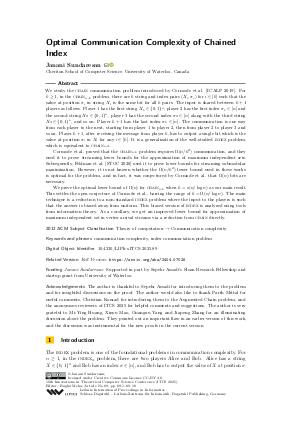LIPIcs.ITCS.2025.89.pdf
- Filesize: 0.81 MB
- 18 pages

 Creative Commons Attribution 4.0 International license
Creative Commons Attribution 4.0 International license

We study the chain communication problem introduced by Cormode et al. [ICALP 2019]. For k ≥ 1, in the chain_{n,k} problem, there are k string and index pairs (X_i, σ_i) for i ∈ [k] such that the value at position σ_i in string X_i is the same bit for all k pairs. The input is shared between k+1 players as follows. Player 1 has the first string X₁ ∈ {0,1}ⁿ, player 2 has the first index σ₁ ∈ [n] and the second string X₂ ∈ {0,1}ⁿ, player 3 has the second index σ₂ ∈ [n] along with the third string X₃ ∈ {0,1}ⁿ, and so on. Player k+1 has the last index σ_k ∈ [n]. The communication is one way from each player to the next, starting from player 1 to player 2, then from player 2 to player 3 and so on. Player k+1, after receiving the message from player k, has to output a single bit which is the value at position σ_i in X_i for any i ∈ [k]. It is a generalization of the well-studied index problem, which is equivalent to chain_{n, 2}.
Cormode et al. proved that the chain_{n,k} problem requires Ω(n/k²) communication, and they used it to prove streaming lower bounds for the approximation of maximum independent sets. Subsequently, Feldman et al. [STOC 2020] used it to prove lower bounds for streaming submodular maximization. However, it is not known whether the Ω(n/k²) lower bound used in these works is optimal for the problem, and in fact, it was conjectured by Cormode et al. that Ω(n) bits are necessary.
We prove the optimal lower bound of Ω(n) for chain_{n,k} when k = o(n/log n) as our main result. This settles the open conjecture of Cormode et al., barring the range of k = Ω(n /log n). The main technique is a reduction to a non-standard index problem where the input to the players is such that the answer is biased away from uniform. This biased version of index is analyzed using tools from information theory. As a corollary, we get an improved lower bound for approximation of maximum independent set in vertex arrival streams via a reduction from chain directly.




Feedback for Dagstuhl Publishing